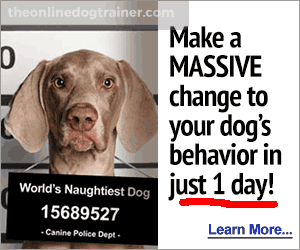Yes, our dogs are getting obese as well. It is estimated that 40% of dogs are overweight. Weight gain can be caused by medical conditions that require veterinary intervention, but most often it is the result of poor feeding habits by the owner; the dog either gets too much of his own food, too many handouts of food from the human dinner table, a food that is too high in calories or too many treats. Dogs can easily train people to give them excess treats.

One of the reasons dogs are so popular is that humans are conditioned to respond to their “cuteness”. Giving your dog excess treats doesn’t mean you love him more. It’s really the opposite: owners who feed their dogs too much or too often are increasing the chances their pet will have serious health problems. Just as with humans, obesity can lead to organ damage, including to the heart and lungs. Joint problems and arthritis can also occur. Most veterinarians say that chronic overweight leads to shortened life span.
Look at his Ribs
Examining your dog’s ribs is a good indication of whether he is at a healthy weight. The ribs should not visibly protrude; that could mean he is underweight. On the other hand, if it is difficult for you to feel his ribs (because of the roll of fat there), he is probably overweight. What is considered normal does vary by breed, however. Naturally lean canines such as greyhounds do have ribs that are visible.
Another test is to stand up and look at your dog from above. He should have an obvious waistline, not a sausage or barrel shape.
What do I Feed a Dieting Dog?
If you find yourself with a pudgy pup, you need to cut back on giving him treats or extras such as table scraps, and come up with a food that helps him lose excess pounds without causing him to feel starved. There are specially formulated dog foods that have fewer calories. You can also supplement his food with such things as chopped up vegetables that provide bulk, so he is satisfied when he’s finished eating. If you’re buying canned vegetables buy the kind that has no added salt. Frozen vegetables need to be defrosted of course, but not necessarily cooked. Raw veggies work as well to fill your pup up. A food with higher moisture content, such as canned dog food, can also help give him a feeling of being full.
Exercise and Treats in Your Dog’s Diet
Attack a weight gain problem by increasing your dog’s exercise. If you go on a 25 minute walk with him each morning, gradually step it up to 50 minutes. Spend more time playing with him in the back yard. Your dog will greatly appreciate the extra attention and you will soon notice him losing weight. And don’t forget, the increased activity is good for your weight, and your heart, as well.
Feeding your dog excessive treats is often as much a cause of overweight as what they get in their regular daily feeding. Small dogs are particularly susceptible to this; even just a few treats a day can cause weight gain. A rule of thumb is that no more than 10% of his daily calories should come from treats.
Regarding snacks or treats, they can be excellent rewards to use for training purposes, particularly for the absolutely critical things like teaching your dog to come when you call him. But the type of treat is as important as the quantity. Look for dog treats that are lower in fat or calories.
Make Your Own Dog Treats
Another alternative is to make your own healthy dog treats. This isn’t as difficult as it sounds.
Sometimes dogs gain weight because they figure out how to steal food from their human friends. It may seem funny when your dog dips into a child’s plate, or grabs food off the kitchen counter, but this can lead to serious weight gain and is easily preventable through training and perhaps child proofing cabinets and drawers so your dog can’t get them open when you’re not looking. Weight gain isn’t the only concern here. Some people foods are absolutely toxic for dogs, such as chocolate.
It Takes Time to Reverse Over Feeding
In dealing with overweight dogs, remember that the problem accumulated over time and it will take time to solve. You should gradually increase his exercise, but just as with humans, you don’t want to overdo the exercise if he isn’t used to it. Your vet might advise you to start your dog on a food specially formulated for weight loss. You may want to make this transition gradually as well; an abrupt change in food can sometimes cause stomach upset, vomiting or diarrhea.
One pet food manufacturer recommends a 7 day transition period from the old food to the new, gradually increasing the percentage of new food from 25% to 100%.
It’s good to keep in mind that any sudden change in weight, up or down, could be a sign of a medical problem that needs veterinary attention immediately. One of the major pet food chains has a vet office inside. There’s no charge to weigh your dog to keep track of your pudgy pet’s poundage.

